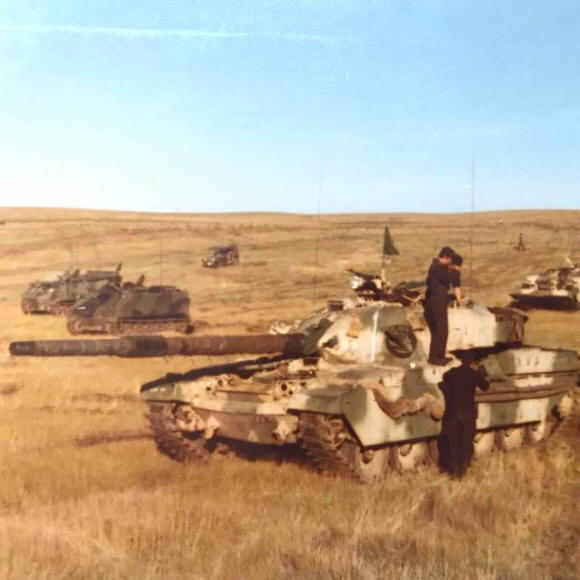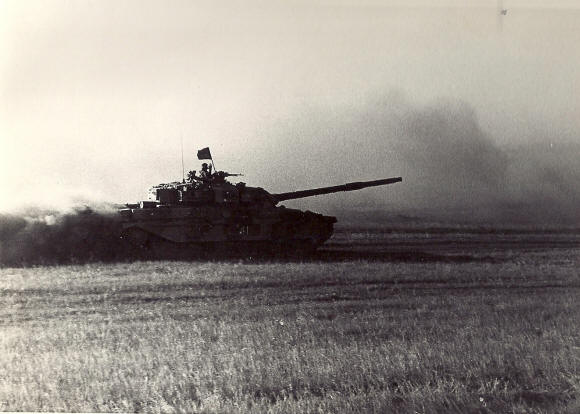|

THE
ULTIMATE training, for us tank soldiers at least, was in
Canada, or more specifically at the British Army
Training Unit, Suffield (BATUS), in Alberta. BATUS was,
and is, a remarkable training facility which the British
Army has used under licence from the Canadian Government
since 1972. It comprises some thousand square miles of
prairie in western Canada where, because of lack of
population, buildings, and infrastructure, we were free
to manoeuvre and fire our weapons almost at will.
For a tank troop leader it is the confirmation and
testing of competence, a rite of passage between
enthusiastic amateur and professional if you like, where
every aspect of military skill is applied to a variety
of problems set by the staff permanently based there. It
is also a hurdle at which many commanders and Regiments
have fallen over the years and, while officially no
report is produced to anyone apart from the commanding
officers of units who go there, the word soon gets out
when units and individuals are found wanting.

On
average, whilst stationed in Germany as part of 1 (Br)
Corps, you might expect to go to Canada once every two
years. But you didn’t go as a regiment, you went as a
battle group (BG), an all arms organisation based on a
regimental headquarters with all the required bits and
pieces from other units tacked on. When I first went to
BATUS in 1981 with my troop it was as part of the Scots
Guard BG; C and D Squadrons 4th Tonks were their tank
support, but it was essentially their exercise.
I rather liked the Scots Guards. True, they were quite
different to us in many ways, and their relationship
between officers and soldiers was more formal than ours.
But they were infantry soldiers and didn’t have that
extraordinary close bonding that came with serving in a
tank crew. In the field I thought they were really,
really good. In barracks, in the officers’ mess, they
had this thing where if you wore your hat at breakfast
it signified that you didn’t want anyone to talk to you.
We thought this was really funny, and went out of our
way to engage anyone so attired in conversation, just
for the Hell of it. Being Guards officers they indulged
us and were endlessly charming and polite. We got on
just fine.
I can’t actually remember how we got from Germany to
Canada the first time, but assume we flew civvy from
Dusseldorf to Calgary. If it had been the RAF we would
have been kept waiting for hours while the crew had a
leisurely breakfast and then flown backwards across the
Pond (RAF transport aircraft had the seats facing
backwards at that time) but I can’t remember any such
delay. There then followed a bus ride to Camp Crowfoot,
the military base near the wonderfully named town of
Medicine Hat and from whence we would sally forth into
the endless prairies on northern Alberta. Plush is not
the word that springs to mind in describing our
accommodation, but it was fine.
Obviously we didn’t take our tanks with us, so we picked
up our exercise vehicles at the aptly named dustbowl at
Camp Crowfoot, taking them over from the previous BG.
There were always some bits and pieces missing from the
tanks equipment, so all sorts of tricks were employed to
avoid having to pay for “diffies”. We did exactly the
same when we handed over to the next lot! A BG comprised
a lot of vehicles and was a pretty big deal as the
photos show.
Eventually we deployed on to the training area proper,
along the Rattlesnake Road if I remember correctly. Then
we were out on the prairie living off our tanks for
three weeks I think, apart from the occasional shower
truck shuttle back to camp for a clean up. Deploying on
to the area introduced us to the dust. I was the middle
of summer and hadn’t rained for months, so each tank
threw up a huge plume of dust which got everywhere –
mouth, eyes and nose plus other awkward less mentionable
spots. It was also frighteningly hot at times – I
recorded 116̊F (no idea what that is in new money) in
the turret on one occasion.
The Canadian prairie is, somewhat paradoxically, both
bleak and beautiful. The initial impression of
never-ending flatness and loneliness is soon replaced by
delight at the fascinating folds and rises of the land;
far from being flat, the prairie is crossed by numerous
riverbeds, called coullees in this part of the world,
and broken by hills and escarpments which hide
undiscovered valleys and plains. Most of it is wild
grassland, which supports a wide array of wildlife from
occasional herds of wild mustangs down to the numerous
colonies of gophers, some of which are half tame after
being fed by visiting troops over the years. There is
also evidence of man's previous occupation of the area
in the form of stone rings marking where the native
Indians pitched their tepees, usually found in the more
sheltered sites or near the rivers.
The usual progression for exercises was followed, troop
level followed by squadron/company group with the
infantry, and then the full bhuna with the BG, involving
engineers, artillery, helicopters, old Uncle Tom Cobley
and all. The main difference was that we were using real
bullets and manoeuvring at the same time, proper fire
and movement. The area was so vast that we could really
only be a danger to ourselves. Tanks had two white lines
painted down either side of the turret and the basic
rule of thumb was that, if you saw a target and there
was nothing “friendly” within the arc of the two white
lines, you could blast away to your heart’s content. We
were accompanied by members of the BATUS permanent staff
in their dayglo painted vehicles who were there mainly
to maintain safety, but most of the time we were just
left to get on with it.
It had its hairy moments. In those pre-GPS days all
navigation was by old-fashioned map reading. A few of
the old sweats who’d been in the Middle East back in the
day used to talk about using a sun compass, but they
were just swinging the lamp. There were virtually no
features in the terrain – the very few trees were
individually marked – so unless you learned quickly how
to read the contours you would become lost. And tanks
did get lost, and could pop up anywhere, so you had to
be careful. One troop leader was fired at by his
squadron leader who mistook his tank for a target. The
DST round would have gone through the back of the turret
had it hit, but luckily his gunner was having an off
day. Another exercise was brought to a shuddering halt
just as another squadron leader was about to open fire
with half his squadron on the other half commanded by
his 2ic.
Sadly occasionally there were tragic accidents. On one
occasion I remember, an infantry mortar bomb fell short
and against all the odds dropped through the open hatch
of another vehicle, killing the crew. On another
occasion one of the REME* Armoured Recovery Vehicles
(ARV) got lost and wandered through a restricted area
that had the remnants of mustard gas testing during WW2
and the crew received some nasty, but non-fatal
thankfully, burns to the legs. But most of the time it
was exhilaratingly good fun, and I well remember
thinking that there was nothing else in the world I
would rather do.
At Endex we came off the prairie, repaired the vehicles,
cleaned ourselves up and were granted a few days R&R, of
which the less detail the better. Whilst people could,
and did, wander further afield, most of the boys spent
it locally. The nearest town to Camp Crowfoot, Medicine
Hat, was a popular destination. Of particular notoriety
was a bar called the Sin Bin which was out of bounds to
officers such was its reputation. By all accounts it was
dark and cavernous with tables arranged saloon style and
waitress service only. It laid on “adult oriented
entertainment” from lunchtime onwards and the floor was
always sticky with spilt beer. It was, not to beat about
the bush, a bit of a dive. Trouble was not uncommon
there, and the Alberta State Police always stationed two
or three patrol cars outside in the evening to sort out
whatever fracas might develop.
As for me, I took my three weeks’ annual leave at the
end of the exercise with a friend and hitch-hiked down
to San Francisco and back, in the days when you could
still do that sort of thing and live. That, however, is
another story altogether and for another time.
*Royal Electrical and Mechanical Engineers
To come in Part 11; “jollies” and adventure training.
© Stuart Crawford 2020 |
